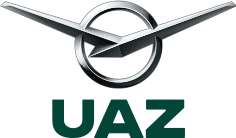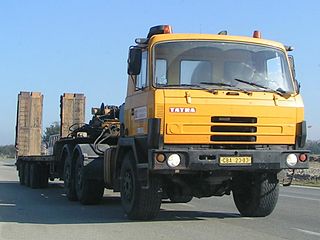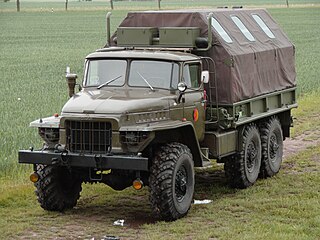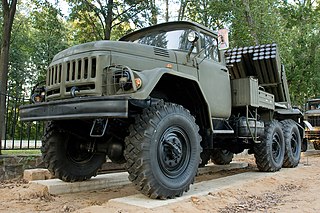
UAZ or Ulyanovsky Avtomobilny Zavod is an automobile manufacturer based in Ulyanovsk, Russia, which manufactures off-road vehicles, buses and trucks. It has been part of the Sollers automotive group since 2000.

The T-80 is a main battle tank (MBT) that was designed and manufactured in the former Soviet Union and manufactured in Russia. The T-80 is based on the T-64, while incorporating features from the later T-72 and changing the engine to a gas turbine. When it entered service in 1976, it was the first production tank to be powered solely by turbine.

The Tatra 815 is a truck family, produced by Czech company Tatra. It uses the traditional Tatra concept of rigid backbone tube and swinging half-axles giving independent suspension. The vehicles are available in 4x4, 6x6, 8x8, 10x8, 10x10, 12x8 and 12x12 variants. There are both air-cooled and liquid-cooled engines available with power ranging from 230–440 kilowatts (310–590 hp). As a successor to Tatra 813 it was originally designed for extreme off-road conditions, while nowadays there are also variants designated for mixed use. The gross weight is up to 35,500 kg (78,264 lb).

The GAZ-66 is a Soviet and later Russian 4x4 all-road (off-road) military truck produced by GAZ. It was one of the main cargo vehicles for motorized infantry of the Soviet Army and is still employed in former Soviet Union countries. It is nicknamed shishiga (шишига), shisharik (шишарик)/shehsherik (шешерик), trueman.

The GAZ-69 is a four-wheel drive off-road vehicle produced by GAZ between 1953 and 1956 and then by UAZ, in 1956–1972, though all of these light truck class vehicles were known as GAZ-69s. It was also produced in Romania until 1975.

A portal axle is an off-road vehicle suspension and drive technology where the axle tube or the half-shaft is offset from – usually above – the center of the wheel hub and where driving power is transferred to each wheel via a simple gearbox, built onto each hub. It gives two advantages: ground clearance is increased, particularly beneath the low-slung differential housing of the main axles — and secondly, any hub reduction gearing allows the axle half shafts to drive the same power but at reduced torque. This reduces load on the axle crown wheel and differential.

The BTR-70 is an eight-wheeled armored personnel carrier originally developed by the Soviet Union during the late 1960s under the manufacturing code GAZ-4905. On August 21, 1972, it was accepted into Soviet service and would later be widely exported. Large quantities were also produced under license in Romania as the TAB-77.

The Volvo Laplander L3314 is a range of military vehicles produced by Volvo.

The BTR-80 is an 8×8 wheeled amphibious armoured personnel carrier (APC) designed in the Soviet Union. It was adopted in 1985 and replaced the previous vehicles, the BTR-60 and BTR-70, in the Soviet Army. It was first deployed during the Soviet–Afghan War.

The ZPU is a family of towed anti-aircraft guns based on the Soviet 14.5×114mm KPV heavy machine gun. It entered service with the Soviet Union in 1949 and is used by over 50 countries worldwide.

Volvo Cross Country C303 is the base model of a range of military vehicles produced by Volvo.

The Ural-375 is a general purpose 4.5 ton 6×6 truck produced at the Ural Automotive Plant in the Russian SFSR from 1961 to 1993. The Ural-375 replaced the ZIL-157 as the standard Soviet Army truck in 1979, and was replaced by the Ural-4320.

The ZIL-131 is a general purpose 3.5 tonne 6x6 army truck designed in the Soviet Union by ZIL. The basic model being a general cargo truck. Variants include a tractor-trailer truck, a dump truck, a fuel truck, and a 6x6 for towing a 4-wheeled powered trailer.

The UAZ Patriot (UAZ-3163) is a mid-size body-on-frame SUV produced by the UAZ division of SeverstalAvto in Ulyanovsk, Russia. It was introduced in 2005 and replaced the older UAZ Simbir (UAZ-3162). Extensive use of newer parts, large carrying capacity, good off-road capabilities and an affordable price predicted good sales in Russia. 12,011 units were sold in the year 2007.

The BVP M-80, is a tracked Yugoslav-made infantry fighting vehicle, produced from the 1980s until the country's collapse in the 1990s.

The UAZ-452 is a family of four wheel drive off-road vans and light trucks with body-on-frame construction and cab over engine design, built by the Ulyanovsk Automobile Plant (UAZ) since 1965. Originally designed for the Soviet military, since 1985 the vans received updates: more modern engines and internationally compliant lighting, as well as new model numbers, UAZ-3741 for the standard van, while (crew-cab) trucks mostly starting with UAZ-3303, often with one or two extra digits specifying the version. From 1997, bigger UAZ-33036 truck variants with a 25 cm (10 in) longer wheelbase, and taller soft-top roof bows and drop-sides were added.

The Chinese Beijing Automobile Works, formerly Beijing Jeep, BJ212 and BAW BJ2020 is a four-wheel drive, originally a 2.4 L (2445 cc) four-cylinder gas-engine powered light-duty offroad utility vehicle in the half tonne class. The original design, depending in large part on Russian off-roaders from UAZ and possibly developed in conjunction with the UAZ-469, debuted in 1965 as the Beijing BJ212. It has been known as the BJ2020 series since the Chinese car classification system was changed in 1989. The BJ212 succeeded the BJ210 model 4x4, whose manufacturing continued and was transferred to Tianjin's First Auto Works which took over manufacturing under the name of TJ210 C. Tianjin's First Auto Works also produce variants with two metal half-doors and an extended wheelbase version with four metal doors.
The Lancia Ro, Lancia Ro-Ro and Lancia 3Ro were 4x2 heavy trucks built by Italian manufacturer Lancia from the 1930s through the 1940s for military and civilian use. The 2-cylinder diesel Ro was produced from 1933 to 1939, the 3-cylinder diesel Ro-Ro from 1935 to 1939 and the improved 5-cylinder diesel 3Ro from 1938 to 1947.

The Pinzgauer is a family of high-mobility all-terrain 4WD (4×4) and 6WD (6×6) military utility vehicles. The vehicle was originally developed in the late 1960s and manufactured by Steyr-Daimler-Puch of Graz, Austria, and was named after the Pinzgauer, an Austrian breed of cattle. They were most recently manufactured at Guildford in Surrey, England by BAE Systems Land & Armaments. It was popular amongst military buyers, and continued in production there throughout the rest of the century.

Bremach was an Italian/American manufacturer of tactical trucks specializing in the manufacturing of military vehicles and 4WD fire engines.





























